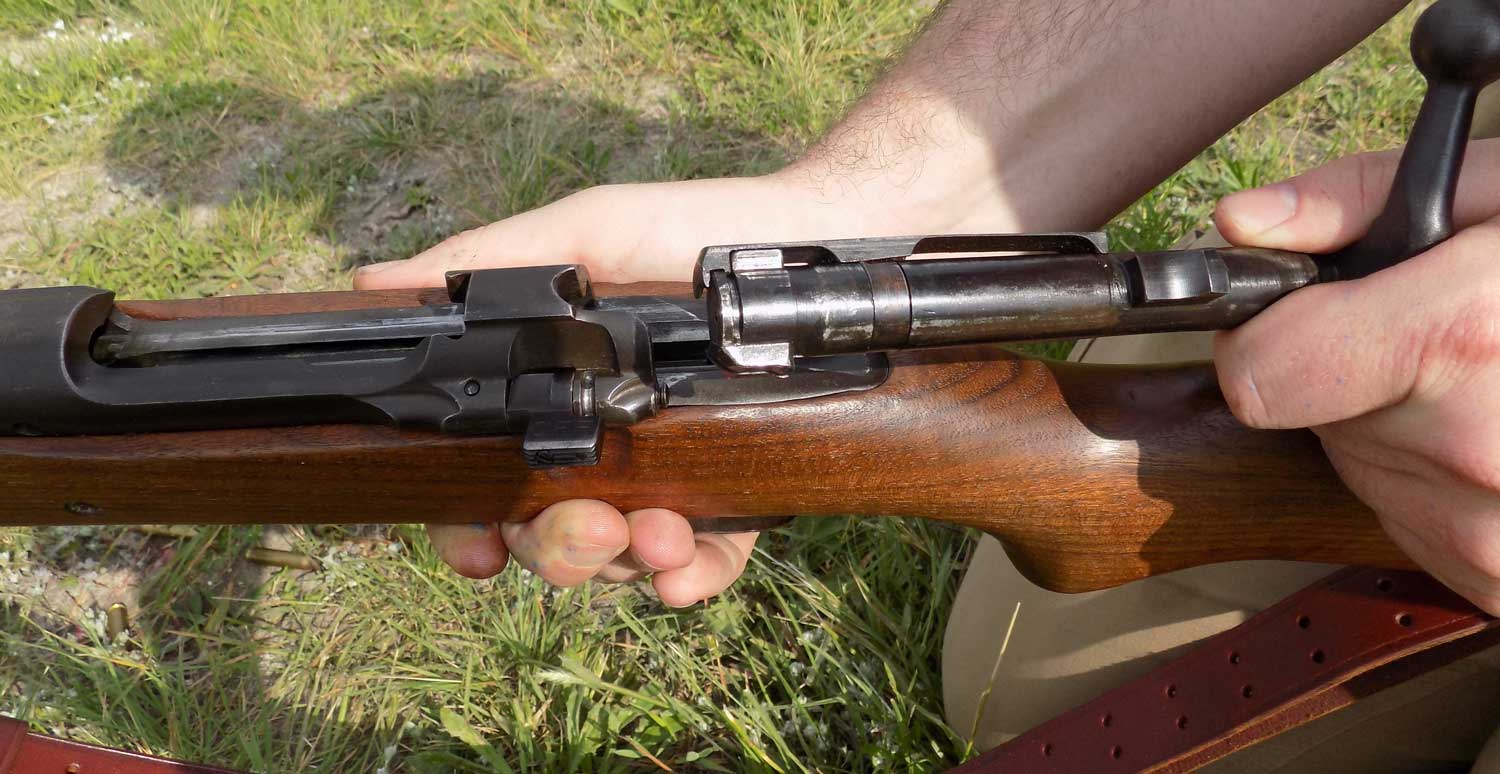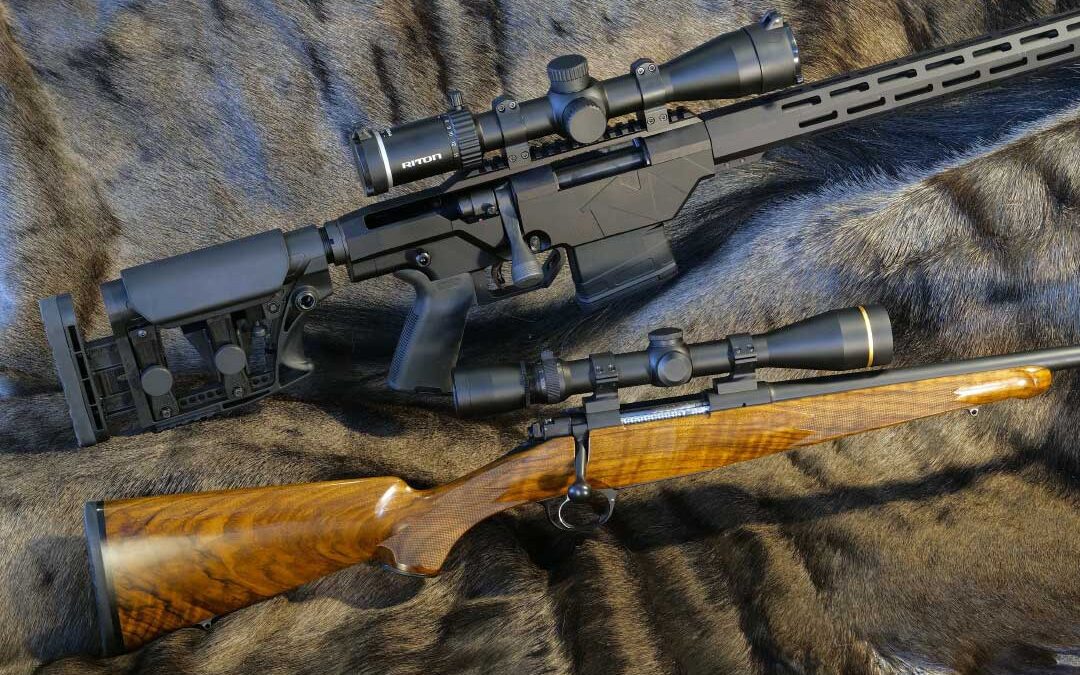If you care to lose friends and inflame people, wade into this with an opinion.
OK, I will.
Fashion in firearms has been around for a long time. It can be seen in elaborately carved and engraved European flintlocks, but also in basic 19th century caplocks and lever-actions whose proud owners hammered their stocks with brass tacks, inset cartridge heads, even lion fangs and grizzly claws. Pop fashion reared its head rather dramatically in the mid-20th century when the “California look” became popular. The basic utilitarian stock lines of a hunting rifle were suddenly flared radically at the pistol grip, cut back at a rakish angle at the forend tip, and mounded with broad, roll over combs. White-line spacers became the rage. Then we had a brief fling with basket weave checkering. But eventually, beginning with the sensible, pragmatic Bill Ruger, classic, traditional stock lines returned. Justifiably. Because they’ve been proven to work.
In conjunction with or despite cosmetic fashion, hunting rifle design seems to have evolved throughout the 20th century to mold the perfect tool for hunting game animals. (You could make this statement about the long bow, too, but this isn’t an archery column.) The century started with the lever-actions dominant, but sporterized bolt-action military rifles began winning converts, especially after WWI introduced tens of thousands to the Springfield 30-06 and liberated Mausers. Manufacturers played variations on the theme, of course, but the basic length, weight and lines of a Mauser M98 sporting bolt-action, a Winchester M70 Featherweight, Remington M700 Mountain Rifle or Dakota 76 proved nigh perfect. They still are, doing everything that needs to be done reliably and well without excess. Even if bedecked and bejeweled with superfluous engraving, eye popping walnut and gold inlays, these rifles and others like them from Browning, CZ, Ruger, Kimber, Cooper and half a dozen others remain efficient, effective and unencumbered.
The same practical hunting performance, minus quick follow-up shots, applies to sleek, trim falling-block and break-action single shots such as the Ruger No. 1, Dakota Model 10, Blaser 95 and Merkel K3. There is no superfluous bulk, no gratuitous curves, holes, bolts or levers. Oh, there were at one time, Schuetzen single shots especially sprouting garish curves, massive butts, pronged butt plates and baroque trigger guards with more curlicues than a wrought iron fence. Which brings us to some modern rifle “platforms,” specifically the multi-adjustable bolt-action extreme range rifles and many ARs.
Before I dive any deeper into this pit, let’s nip some rage and name calling in the bud: I am not contending or even suggesting that today’s AR-style, autoloading rifle is useless, evil, should be outlawed or anything of the sort. Nor am I saying PRS-style rifles — those all-metal “chassis” rifles with more exposed nuts and bolts and holes and divots and ledges and levers than your average self-propelled farm implement — aren’t perfectly designed for maximum, extreme range precision. If you want to drop a dime on a 16-inch plate at 1,500 yards, saddle up one of these specialty rifles and clang away. If you need to trim the local feral hog population from a helicopter, tie in with an AR and a basket of 20-round magazines and let ’er rip. I acknowledge the superiority of both those rifle platforms for their intended applications. I merely question their suitability for general big game hunting.
Before I provide evidence in support of my contention, let’s define “general big game hunting.” By that I mean “sport hunting,” the 150-year-old enterprise of a licensed hunter propelling himself/herself over and through fields, grasslands, brushlands, swamps, hills, woodlands, forests, mountains and other terrains and habitats in search of game from 10-pound dik dik to 12,000-pound elephant. And most especially mule deer, elk, moose, Dall sheep and the other game species of North America’s best places.
The above-mentioned searching could involve internal combustion machines, but should at some point enliven to walking, backpacking or horse riding, traditional activities common to hunting. Of course, that includes sitting still and waiting for game to deliver itself, a tradition going back to early hominids dropping stones out of trees. For this style of hunting, my concerns about bulk and balance in a hunting rifle carry less validity. My focus is the roaming rifle, the tool you carry while pursuing game rather than waiting for it.
With that proviso, let us now examine what makes the classic 20th century bolt-action rifle (and to a lesser extent, break-action and falling block rifles) so effective for hunting.
1. Firepower. By this we mean both the energy carried by the projectile and the quantity of bullets that can be quickly and accurately sent to the target. Both bolt-actions and single-shots can be scaled to fit everything from 22 rimfires to 50-caliber (505 Gibbs) dangerous game rounds. Repeaters generally hold three to a maximum of five rounds plus one in
the chamber. Given that most big game tags limit the holder to one animal per day, or one per season, and increasingly one per lifetime, a 5-shot magazine would seem more than adequate. Single shots, obviously, carry but one round in the chamber, but additional rounds can be held in various ammo belts or pockets. As one single-shot aficionado pointed out, “It’s not a single-shot; it’s a single-loader.” And highly trained single shot operators can single-load surprisingly quickly.
2. Weight. The above rifles are routinely built weighing from 4.8 pounds to 13 pounds, weights commensurate with controlling recoil generated by the cartridges chambered. The lighter models tag along on the hunt with minimum drain on the carrier’s endurance. Trust me, backpacking over the Alaska Range with a 5-pound rifle is more fun than with an 8-pound rifle.
3. Length. These can be scaled to handle cartridges as short as 1.8 inches and as long as 4 inches. Barrels can be as long 30 inches for maximizing muzzle velocity or as short as 16 inches for maneuvering through dense woodlands and brush.
4. Balance and Comfort.
The classic, slim stocks of most bolt-actions and single-shots generally balance just in front of the trigger bow, the relatively narrow stock belly easily cradled for comfortable one-hand carry. Slung over one shoulder or bandolier style across the back, the clean belly line still contributes to comfortable carry with no sharp, hard projections. With their balance centered between the hands, these rifles can be manipulated quickly to point of aim.
5. Cost. Bolt-actions and single-shots sell for as little as $300 new. Premium models climb up the social ladder as high as you care to pay. A $30,000 model (borrowed) was the most valuable I ever had the pleasure of firing at game. It killed no more effectively than the $300 models, but I felt as if I were floating on a higher plane during the short time I carried it.

Pulling the bolt on a M1903 Springfield.
6. Durability and Dependability. Bolt-actions and single-shots have a minimum of moving parts. Malfunctions and failures to feed or eject are rare. Bolt-actions can be field stripped and cleaned, often right down to the firing pin, with few or no tools. Carbon fouling is confined mainly to the barrel, leaving locking lugs, extractors and the receiver relatively clean and functional for dozens, even hundreds of shots. Their strong, manual camming action can lock into battery slightly oversized or “sticky” rounds that would stop an autoloader.
7. Accuracy. Bolt-actions can be optimized for accuracy via easily adjustable or replaceable triggers. Stocks — whether wood, molded plastic or stiff fiberglass/Kevlar — are easily free-floated, full-length bedded, bedded with pressure at the tip and otherwise fine-tuned for accuracy.
8. Maintenance. Other than external waxing or light oiling to prevent rust, bolt-actions need little more attention than a tiny dab of grease on the locking lugs and cocking cam. Barrels are easily and properly examined and cleaned from the breach by removing the bolt.
9. Quiet Operation. This isn’t a big deal, but the ability to quietly chamber a round is a nice feature of bolt-actions, falling block and break-action single shots. So is quietly slipping rounds out of chambers when extra safety (such as when crossing fences, climbing rockslides, etc.) is needed. I’ve more than once scaled steep mountain slopes and short cliff faces to within 100 yards of my quarry. Being able to do that with an empty chamber, then lock home a round without alerting my prey, made
the difference.
Those are the nine attributes that I think make classic 20th century bolt-action and single-shot sporting rifles ideal for hunting. I can’t imagine what, if anything, they are missing. A century of refinements has given us the perfect tools. All that remains is training ourselves to use them to their full potential.

